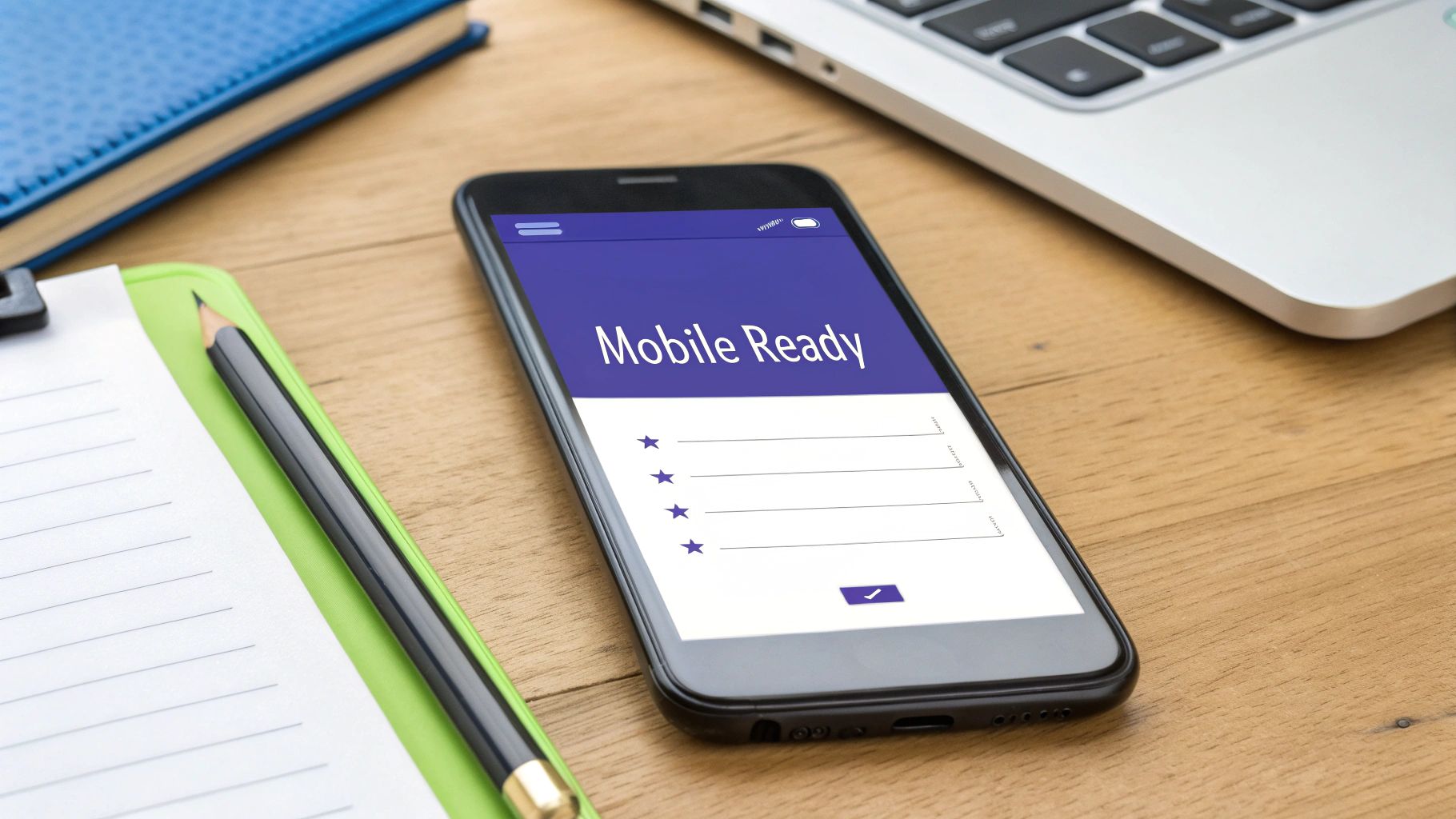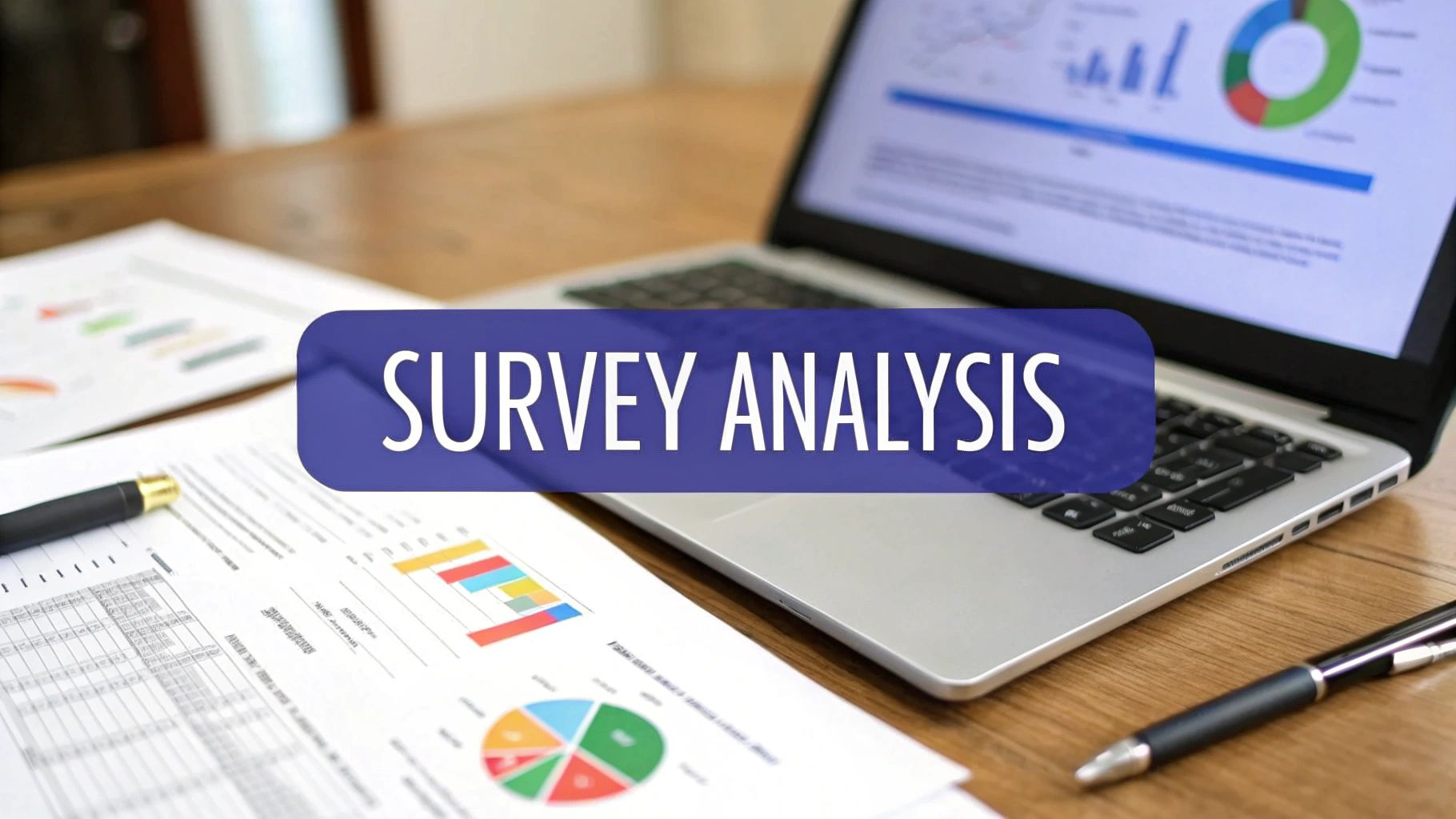8 Essential Survey Design Best Practices for SaaS in 2025
Master the art of feedback with these survey design best practices for SaaS. Boost completion rates, get quality data, and drive growth. Learn more now!

How do you get honest, actionable insights directly from the source for your business? The answer is I the design of your surveys. Generic surveys yield generic data, or worse, lead to high abandonment rates and user frustration. This guide cuts through the noise.
We will explore eight critical survey design best practices, each specifically tailored for the unique challenges and opportunities SaaS teams face. You will learn not just the 'what' but the 'how' for each principle, complete with actionable steps and real-world examples.
The goal is to empower you to build surveys that users actually want to complete. By implementing these strategies, you can gather the high-quality data needed to reduce churn, refine your product roadmap, and accelerate sustainable growth. Let's move beyond basic feedback forms and start creating intelligent feedback loops that truly power your business decisions and fuel your product's evolution.
1. Clear and Specific Question Formulation
The foundation of any effective survey is the quality of its questions. Clear and specific question formulation is one of the most critical survey design best practices because it ensures you gather accurate, actionable data. Vague questions lead to ambiguous answers, rendering your data useless for making informed product or business decisions. The goal is to craft questions that are so clear, every respondent interprets them in the exact same way.

This involves stripping away jargon, avoiding assumptions, and focusing each question on a single, specific concept. By doing this, you eliminate respondent confusion and reduce the cognitive load required to answer, which improves completion rates and data quality. For a deeper dive into the mechanics, you can explore how to write effective survey questions.
How to Implement Clear Questioning
A common mistake is asking broad questions that are open to interpretation. Instead of pinpointing a specific metric or experience, they invite subjective responses that are difficult to quantify and compare.
- Vague: "How do you like our new dashboard?"
- Specific: "On a scale of 1 to 5, how easy is it to find the 'Analytics' section on our new dashboard?"
The specific version targets a measurable aspect of user experience: discoverability. Similarly, Airbnb excels at this by asking post-stay questions like "How clean was the accommodation?" or "How was the check-in process?" instead of a generic "How was your stay?".
Actionable Tips for SaaS Teams
- Avoid Double-Barreled Questions: Never ask about two different things in one question. Split "How satisfied are you with our platform's speed and design?" into two separate questions.
- Use the 'One Breath' Rule: If you can’t read the question aloud in a single, comfortable breath, it's too long and complex. Simplify it.
- Pilot Test Internally: Before launching, have colleagues from different departments take the survey. If they ask for clarification, your respondents will too.
To gather rich, qualitative data and gain deep insights, refer to a comprehensive list of open-ended questions examples that can significantly enhance your survey.
2. Logical Flow and Question Sequencing
The order in which you ask questions is just as important as the questions themselves. Logical flow and question sequencing is a core tenet of survey design best practices, as it guides the respondent through a natural, intuitive path. A well-structured survey moves from general topics to specific ones, building trust and momentum while minimizing cognitive friction and potential bias. When the flow is disjointed or confusing, respondents are more likely to abandon the survey or provide thoughtless answers.

This strategic ordering, popularized by survey methodology experts like Don Dillman, ensures that earlier questions don't improperly influence answers to later ones. A logical progression makes the experience feel more like a conversation and less like an interrogation, which is crucial for maintaining engagement and collecting high-quality data.
How to Implement Logical Sequencing
A common error is to jump directly into sensitive or highly specific questions without establishing context. This can startle or confuse respondents, leading to inaccurate data. The key is to create a funnel effect, starting broad before narrowing the focus.
- Disorganized: Asking about pricing satisfaction immediately after a user signs up for a free trial.
- Logical: An employee survey that starts with general job satisfaction questions before moving into specific topics like management feedback or compensation.
Netflix effectively uses this by first asking about general viewing habits and content preferences. Only after establishing this broad context do they ask for feedback on specific original shows or new platform features.
Actionable Tips for SaaS Teams
- Start with Easy 'Warm-Up' Questions: Begin with simple, engaging, and non-sensitive questions to build momentum and make the respondent feel comfortable.
- Place Demographics Last: Unless needed for screening or routing logic, ask for demographic information (age, role, company size) at the end. Respondents are more willing to share this personal data once they have invested time in the survey.
- Group Similar Topics: Cluster questions about the same feature or experience together. Use clear section headings or transition statements ("Now, we'd like to ask a few questions about our new reporting feature...") to signal a topic shift.
- Use Skip Logic Intelligently: Guide users past irrelevant questions based on their previous answers to create a personalized, more efficient experience.
For a visual explanation of how question order can impact survey results, this video offers valuable insights.
3. Appropriate Sample Size and Sampling Method
Gathering survey data is pointless if the results don't accurately reflect your target audience. Determining the right sample size and using a sound sampling method are survey design best practices that ensure your findings are statistically significant and representative. Too small a sample can lead to anecdotal conclusions, while an improperly selected one can introduce bias, making your data misleading for crucial business decisions.

The goal is to survey enough people to have confidence in the results without wasting resources by surveying too many. This balance is key to generating reliable insights you can act on, whether you're validating a new feature idea or measuring overall customer satisfaction. The work of pioneers like George Gallup in modern polling established the importance of these scientific principles.
How to Implement Proper Sampling
A common error is surveying a convenience sample, like your first 100 signups, and assuming their feedback represents your entire user base. This approach ignores population diversity and can skew results significantly. A more scientific approach is required for trustworthy data.
- Incorrect: "Let's just email the first 500 users on our list."
- Correct: "Our user base is 60% enterprise and 40% SMB. We will use stratified random sampling to survey 240 enterprise and 160 SMB users to ensure our sample reflects this segmentation."
This correct method, known as stratified sampling, ensures subgroups within your population are proportionally represented. For instance, the U.S. Census Bureau uses this method for its American Community Survey to ensure data accurately reflects the nation's diverse demographics.
Actionable Tips for SaaS Teams
- Use Sample Size Calculators: Tools like SurveyMonkey's calculator can help you determine the necessary sample size based on your population size, confidence level, and desired margin of error.
- Factor in Response Rates: If you need 400 completed surveys and expect a 10% response rate, you must send the survey to at least 4,000 people. Always plan for non-responses.
- Document Your Methodology: Be transparent about how you selected your sample. This builds trust in your findings and allows for proper scrutiny and replication if needed.
- Consider Your Margin of Error: A standard margin of error is typically between 3% and 5%. A lower margin of error requires a larger sample size but provides greater precision.
4. Response Scale Optimization
The way you structure your answer options is just as important as the questions you ask. Response scale optimization is a crucial survey design best practice because it involves carefully selecting and designing rating scales that capture respondent opinions accurately. A poorly designed scale can confuse participants or introduce bias, skewing your data and leading to flawed conclusions about user satisfaction or product performance.

The goal is to choose a format that is intuitive for the user and provides you with data that is easy to analyze and act upon. This means deciding on the number of points on a scale, how to label them, and ensuring consistency across your entire survey. Properly optimized scales reduce respondent fatigue and increase the reliability of the feedback you collect.
How to Implement Response Scale Optimization
The right scale depends on what you want to measure. For measuring agreement, a Likert scale is the standard. For gauging loyalty, the Net Promoter Score (NPS) methodology, developed by Fred Reichheld and Bain & Company, provides a clear framework.
- Vague Scale: "Rate our customer support: Good - Bad"
- Specific Scale: "How satisfied were you with our customer support? (Scale: 1 - Very Unsatisfied, 2 - Unsatisfied, 3 - Neutral, 4 - Satisfied, 5 - Very Satisfied)"
The specific version uses a balanced, 5-point Likert scale with clear labels for each point, including a neutral midpoint. This captures a more nuanced range of sentiments than a simple binary choice. Similarly, Amazon's 5-star rating system provides a universally understood scale for quick product assessments.
Actionable Tips for SaaS Teams
- Use Odd-Numbered Scales for Neutrality: A 5 or 7-point scale allows for a true neutral option, preventing respondents from being forced to lean one way when they have no opinion.
- Keep Scale Direction Consistent: If 1 means "negative" and 5 means "positive" in your first question, maintain that pattern throughout the survey to avoid confusing users.
- Clearly Label Endpoints: Always define what the highest and lowest numbers on your scale represent (e.g., "1 = Not at all likely" and "10 = Extremely likely").
- Test Your Scales: Before a full launch, run a small pilot test to see if your target audience understands the scales as intended. This helps catch potential confusion early.
5. Mobile-Responsive Design
In an era where most digital interactions occur on smartphones, ensuring your survey is mobile-responsive is no longer optional; it's a fundamental requirement. Mobile-responsive design is a crucial survey design best practice because it guarantees a seamless experience for users on any device, from desktops to tablets and phones. A survey that is difficult to navigate on a small screen will lead to high abandonment rates and skewed data, as you'll miss out on a significant portion of your audience.
The core principle is to create a survey that automatically adapts its layout, font size, and interactive elements to fit the screen it's being viewed on. This eliminates the need for frustrating pinching and zooming, providing a clean, user-friendly interface that encourages completion. A well-optimized mobile survey respects the respondent's time and device, directly impacting the quality and quantity of the data you collect.
How to Implement Mobile-Responsive Design
Many modern survey platforms build responsiveness in by default, but you still need to be mindful of the user experience. A common failure is designing a complex survey on a large desktop monitor without considering how it will translate to a 6-inch phone screen.
- Poor Experience: A multi-column layout with tiny radio buttons and long, horizontal matrix questions that force users to scroll sideways.
- Optimized Experience: A single-column layout where each question is presented clearly, with large, tappable buttons and vertical scrolling only.
Consider Uber's post-ride rating system. It's a perfect example of mobile-first design: a simple star rating followed by optional, pre-selected tags that can be tapped with a thumb in seconds. Similarly, Instagram's story polls are designed for quick, effortless mobile interaction. These companies understand that mobile surveys must be fast and frictionless.
Actionable Tips for SaaS Teams
- Embrace Single-Column Layouts: This is the golden rule for mobile. It prevents horizontal scrolling and keeps the user focused on one question at a time.
- Make Touch Targets Large: Ensure buttons, checkboxes, and radio buttons are large enough to be easily tapped with a finger without accidentally selecting the wrong option.
- Minimize Scrolling: Break longer surveys into multiple, shorter pages. This reduces the cognitive load and makes the survey feel less intimidating on a small screen.
- Test on Real Devices: Before launching, test your survey on various iPhones, Android devices, and tablets to catch any rendering or usability issues.
To effectively capture user feedback directly from your platform, it's essential to use tools designed for this purpose. You can discover more about implementing this on your site by reading about the best website survey tools.
6. Minimizing Survey Length and Fatigue
In the world of surveys, time is a currency that respondents are unwilling to spend freely. Minimizing survey length is a fundamental survey design best practice because it directly combats respondent fatigue, a major cause of survey abandonment and low-quality data. A long and demanding survey signals a lack of respect for the respondent's time, leading them to either quit midway or rush through answers without care. The goal is to be ruthlessly efficient, collecting only the most critical information to keep the experience brief and focused.
This principle, championed by research from methodologists like Don Dillman and institutions like the Pew Research Center, emphasizes that shorter surveys yield higher completion rates and more thoughtful responses. By strategically curating your questions and optimizing the survey flow, you make participation less of a chore and more of a quick, manageable task. This respect for the user's time is crucial for maintaining a positive brand perception and ensuring a steady stream of reliable feedback.
How to Implement Brevity
A common pitfall is the "just one more question" mindset, which bloats surveys and tanks engagement. The key is to prioritize questions mercilessly and design for speed.
- Bloated: A 40-question annual customer feedback survey asking about every single feature.
- Concise: A 5-question pulse survey sent quarterly, focusing only on recent updates or a specific user journey.
Uber’s post-ride survey is a masterclass in this, often containing just a star rating and one or two optional follow-ups, taking less than 30 seconds to complete. Similarly, LinkedIn’s internal pulse surveys for employees typically contain only 5-7 questions, ensuring high participation by making the time commitment minimal.
Actionable Tips for SaaS Teams
- Target a 5-10 Minute Max: As a rule of thumb, aim for a completion time under 10 minutes, and ideally under five. Use your survey tool's estimated time feature and test it.
- Show a Progress Bar: Always include a progress bar or a "Question X of Y" indicator. This manages expectations and motivates users to finish by showing them the end is in sight.
- Prioritize Ruthlessly: Place your most critical, must-have questions at the beginning. If a respondent abandons the survey, you will have at least captured the most valuable data.
- Use Matrix Questions Sparingly: While efficient for you, long grids of questions are visually intimidating and mentally draining for respondents. Use them only when absolutely necessary.
By keeping surveys short and focused, you significantly boost your chances of gathering high-quality data. For more strategies on getting users to complete your surveys, you can improve your survey response rate with targeted techniques.
7. Thorough Pre-Testing and Pilot Studies
Launching a survey without pre-testing is like releasing software without QA; you risk deploying a flawed product that yields unusable results. Thorough pre-testing is a non-negotiable step in survey design best practices, involving a small-scale trial run before the full launch. This process uncovers hidden problems with question clarity, technical glitches, logical flow, and completion time. It is your final quality gate to ensure the data you collect is reliable and the respondent experience is smooth.
By testing your survey with a small, representative sample, you can identify and rectify confusing questions, broken logic, or formatting issues across different devices. This prevents the large-scale data corruption and respondent frustration that can derail an entire research project. Methodologists like Gordon Willis, known for pioneering cognitive interviewing, and organizations like the U.S. Census Bureau have long championed systematic pretesting as essential for survey validity.
How to Implement Pre-Testing
A common mistake is assuming that an internally reviewed survey is ready for the public. Your team has insider knowledge and context that your actual audience lacks. A pilot study exposes these blind spots by simulating the real-world survey experience.
- Flawed: Launching a survey immediately after an internal grammar and spelling check.
- Effective: Deploying the survey to a pilot group of 20 users who match your target persona, then analyzing their responses and feedback before a full launch.
Market research leaders like Nielsen and Kantar never deploy a major survey without first testing it with focus groups or pilot panels. They analyze not just the answers, but also the time taken per question and the drop-off rates to diagnose points of friction.
Actionable Tips for SaaS Teams
- Recruit a Representative Sample: Test with 10-30 people who closely resemble your target audience. Testing with internal staff is good for technical checks, but only a real user can spot confusing industry-specific language.
- Conduct 'Think-Aloud' Protocols: Ask a few pilot participants to share their thoughts out loud as they take the survey. This provides invaluable qualitative insight into how they interpret questions and navigate the survey flow.
- Test on Multiple Devices: Ensure your survey functions flawlessly and looks professional on various desktops, tablets, and mobile devices, as well as different browsers.
- Analyze Pilot Data: Look for unexpected patterns in the pilot results. Are all respondents choosing the same answer for a particular question? Is one question taking significantly longer to answer than others? These are red flags that indicate a potential issue.
8. Bias Reduction and Neutral Framing
One of the most insidious threats to data integrity is survey bias. Implementing bias reduction and neutral framing is a non-negotiable survey design best practice that ensures responses reflect genuine user sentiment, not the influence of your question structure. Bias can subtly creep in through loaded words, question order, or even social pressures, leading you to draw incorrect conclusions and make misguided business decisions. The objective is to design a survey experience that is as objective as a scientific instrument.
This means consciously identifying and neutralizing potential sources of bias, from the words you choose to the order in which you present options. By doing so, you protect the validity of your results and ensure the insights you gather are a true representation of your users' reality. This practice, championed by research bodies like the American Association for Public Opinion Research (AAPOR), is what separates an amateur poll from a professional, data-driven investigation.
How to Implement Neutral Framing
Bias often manifests as leading questions that nudge respondents toward a particular answer or framing that creates a "correct" response. A neutral approach strips away this influence, allowing the respondent's true opinion to surface.
- Biased: "Wouldn't you agree that our new onboarding process is much more intuitive?" (Leading and encourages agreement)
- Neutral: "How would you describe your experience with our new onboarding process?" (Open-ended and non-directional)
Political polls are masters of this, frequently randomizing the order of candidate names to counteract position bias, where options listed first are chosen more often. Similarly, employee satisfaction surveys often use a third-party administrator to mitigate social desirability bias, ensuring employees feel safe to provide honest, critical feedback without fear of reprisal.
Actionable Tips for SaaS Teams
- Avoid Loaded Words: Steer clear of words with strong positive or negative connotations. Replace "innovative feature" with "new feature" or "frustrating bug" with "reported issue."
- Randomize Answer Options: For multiple-choice questions without a natural order (like a 1-5 scale), randomize the option display to prevent order bias.
- Use Forced-Choice Questions: To combat acquiescence bias (the tendency to agree), use forced-choice questions like, "Which statement is closer to your view?" instead of "Do you agree with this statement?".
- Review for Unstated Assumptions: Have multiple team members review questions. A question like, "How often do you use our mobile app's collaboration tools?" assumes the respondent knows about and uses the mobile app. A better approach starts with a filter question.
Survey Design Best Practices Comparison
ItemImplementation Complexity 🔄Resource Requirements ⚡Expected Outcomes 📊Ideal Use Cases 💡Key Advantages ⭐Clear and Specific Question FormulationMedium: requires thoughtful wording and testingModerate: time and expertise in designHigh-quality, reliable data with reduced misinterpretationSurveys needing precise measurement and clarityImproves data accuracy and completion ratesLogical Flow and Question SequencingMedium-High: needs planning and testingModerate: design and possibly testing multiple versionsIncreased engagement and lower abandonmentComplex surveys with diverse topicsMaintains interest and reduces biasAppropriate Sample Size and Sampling MethodHigh: involves statistical calculationsHigh: larger samples and complex samplingStatistically valid, generalizable resultsQuantitative research requiring representativenessEnsures validity and reduces sampling biasResponse Scale OptimizationMedium: design and cultural considerationsModerate: design and pretestingConsistent, high-quality response dataSurveys requiring nuanced opinion measurementEnhances data quality and analysisMobile-Responsive DesignMedium-High: technical design and testingModerate-High: requires development effortHigher response rates and better UX across devicesSurveys targeting a mobile audienceIncreases reach and usabilityMinimizing Survey Length and FatigueMedium: careful prioritization and logicLow to Moderate: focus on designHigher completion rates and better data qualityAny survey where respondent attention is limitedReduces dropout and respondent burdenThorough Pre-Testing and Pilot StudiesHigh: extensive testing and analysisHigh: recruiting participants, timeEarly problem detection and improved final data qualityLarge or high-stakes surveysPrevents costly mistakes and validates designBias Reduction and Neutral FramingHigh: requires expertise and detailed reviewModerate-High: design complexity and reviewMore valid, reliable, and credible dataSensitive topics and research needing rigorous validityMinimizes response biases and errors
From Data Collection to Actionable Growth
Mastering the fundamentals of survey creation is not just about gathering feedback; it's about building a direct line to your users' needs, motivations, and pain points. Throughout this guide, we've explored the essential survey design best practices that separate noisy, unreliable data from clear, actionable insights. By moving beyond generic questions and embracing a methodical approach, you transform your surveys from a simple checklist item into a powerful strategic asset for your SaaS team.
Let's distill the core takeaways. The journey to exceptional survey data is built on a foundation of clarity and logic. This means formulating specific, unambiguous questions, arranging them in a logical sequence, and framing them neutrally to eliminate bias. These steps ensure that the responses you receive are a true reflection of your users' experiences, not a byproduct of confusing design.
Turning Principles into Practice
Remember, the user experience of the survey itself is paramount. Implementing key principles like mobile-first design and minimizing survey fatigue respects your user's time and significantly boosts completion rates. Equally critical are the technical pillars supporting your efforts:
- Optimizing response scales to capture the right level of detail.
- Calculating the appropriate sample size to ensure your findings are statistically significant.
- Conducting thorough pilot tests to catch errors before a full launch.
These practices work in concert to create a seamless and effective feedback loop. You're not just asking questions; you're engineering a process designed for maximum insight and minimum friction.
From Insight to Impact
Ultimately, the value of even the most perfectly designed survey is measured by the action it inspires. The data you collect is a starting point, a rich resource ready to be analyzed and deployed. This is where the process transitions from data collection to strategic execution. For teams looking to integrate these findings into larger initiatives, a strong command of data science project management is essential for translating raw survey data into tangible product improvements and business growth.
By embedding these survey design best practices into your team's DNA, you build more than just better surveys. You cultivate a customer-centric culture that listens, understands, and responds with agility. This commitment is the true engine of sustainable growth, turning user feedback into your most reliable competitive advantage.
Ready to put these best practices into action with a tool built for SaaS teams? Surva.ai helps you design intelligent, AI-powered surveys and automates the process of turning insights into growth. Start building more effective surveys today at Surva.ai.


